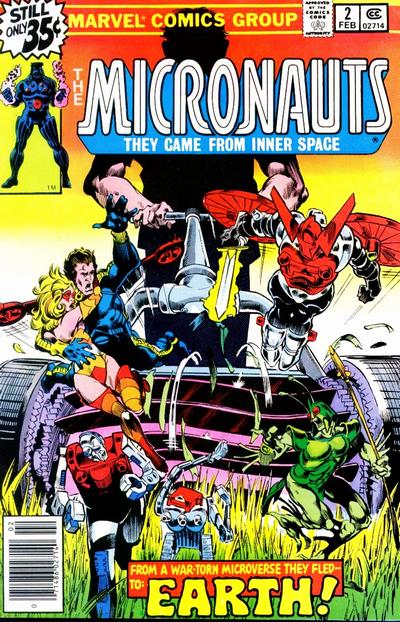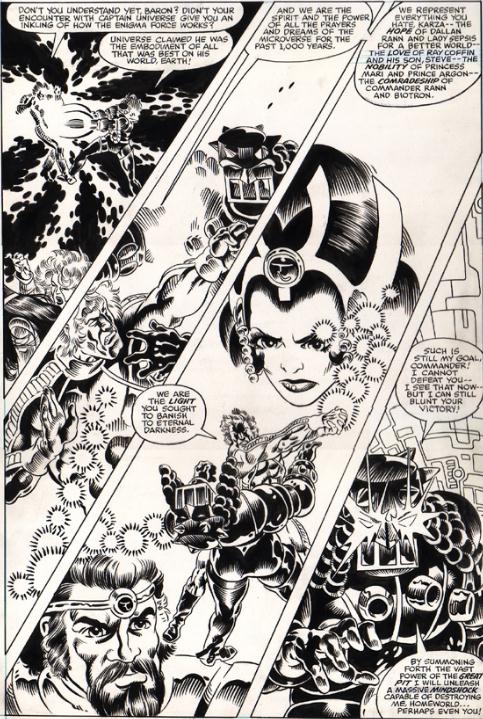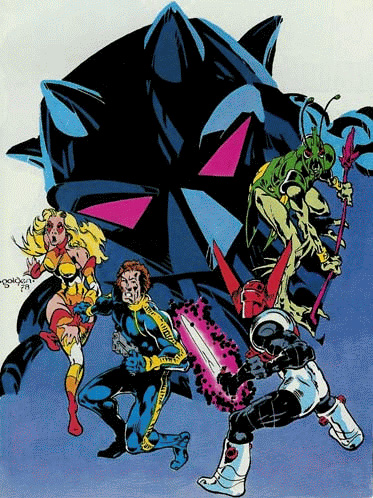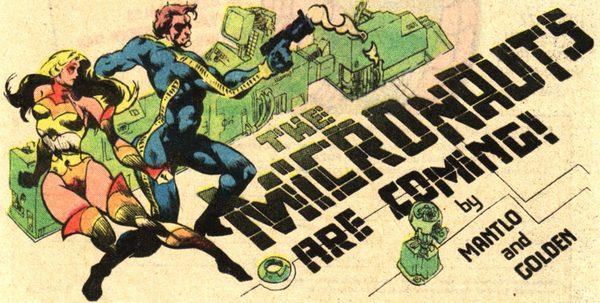
Arcturus Rann, an explorer who has spent 1,000 years in space exploring the cosmos, returns to Homeworld only to find it under the despotic rule of Baron Karza, a ebony armored despot who rules through fear and offering the privileged classes immortality through his body banks. Karza is actually Rann’s old mentor who killed Rann’s parents after he left on his journey and took over their world and the galaxy. Teaming up with the princess Marionette, the stoic warrior Acroyear, the goofy warrior Bug and the robotic duo of Biotron and Microtron, Rann escapes from Karza. As they approach the fringes of space and the Spacewall, the team of rebels find themselves thrown into our world, Florida to be exact. The catch is that they were 3.75 inches tall, exactly the size of the toys. Under Mantlo and Golden’s creative hand, the Micronauts spend their first 12 issues fighting to get back to their world to overthrow Karza.
Mantlo had to have wanted to write Star Wars and when he didn’t get that gig, Micronauts ended up as his runner up prize. The only thing that the toys had in common with Star Wars originally was space ships and an villain who was in black armor. Mantlo and Golden graft the story of rebellion onto these characters and instead of setting the story in a galaxy far, far away, they bring it closer to home. The tagline for the series was “They came from inner space.” Their worlds were the molecules that make up everything around us so they could be anywhere and everywhere. In 1979 following on the burgeoning science fiction/space opera craze, drawing spaceships and aliens fighting around NASA’s Cape Canaveral facilities was pretty awesome to most 9 year olds at the time.
Mantlo takes almost everything he can from Star Wars and repackages it. Rann is a both Luke Skywalker and Obi Wan Kenobi rolled into one. Marionette equals Princess Leia while Acroyear and Bug are a recasting of Han Solo and Chewbacca. There’s even an Enigma Force, an all powerful but unseen force that’s wielded by the hero. Heck, the twelfth issue opens with a victory celebration, echoing the final scene of Lucas’s movie. All that was missing from all of this was a John Williams’ score. But Han and Chewie never got to fight the Man Thing. Setting Micronauts in the Daytona Beach of the Marvel Universe, instantly makes these comics that much cooler than they would have been if this was any old space opera.
Golden never was the most productive artist in comics. The Micronauts #1-12 is only the first of two twelve issue runs he ever did (the other being The Nam #1-11 and #13) but he would influence artists for the next couple of decades. Look at almost any of the original Image artists and you can trace their influences directly or indirectly back to Golden. In an age where Marvel’s house style was still heavily influenced by Jack Kirby’s power and Neal Adam’s realism, Golden brought a flourish to that style. His expressive and acrobatic figures had a bounce to them that wasn’t present in many comics. His characters looked like they were ready to spring into action at any moment. And when they did finally fight, their bodies moved in ways that looked more like dancing than fisticuffs. There’s a gracefulness to Golden’s characters, whether he was drawing Batman, soldiers in Vietnam, or microcosmic adventurers, that he achieved with these flowing lines and limbs.
 The other thing about Golden’s art that really made those first issues of The Micronauts so special was the sense of scale he brought to the book. In the first issue, his artwork and Mantlo’s story was about creating new worlds. Golden seemed less interested in recreating the toy designs and instead built new alien cultures. Like Lucas was able to do in the with all of the aliens in Star Wars, Golden built an otherworldly look but figured out ways to make it believable by incorporating some consistency into it. It is in the second issue, where the Micronauts escape to our Earth, that really establishes what Golden is capable of as he has to play with the sense of scale of the 3 ½” Micronauts interacting with the full-sized world that we see everyday. It’s where Golden makes a small yapping dog into a giant monster and an old lawnmower into a giant metal machine of death. And then he and Mantlo introduce a battle with spaceships into the backyard of a Florida home.
The other thing about Golden’s art that really made those first issues of The Micronauts so special was the sense of scale he brought to the book. In the first issue, his artwork and Mantlo’s story was about creating new worlds. Golden seemed less interested in recreating the toy designs and instead built new alien cultures. Like Lucas was able to do in the with all of the aliens in Star Wars, Golden built an otherworldly look but figured out ways to make it believable by incorporating some consistency into it. It is in the second issue, where the Micronauts escape to our Earth, that really establishes what Golden is capable of as he has to play with the sense of scale of the 3 ½” Micronauts interacting with the full-sized world that we see everyday. It’s where Golden makes a small yapping dog into a giant monster and an old lawnmower into a giant metal machine of death. And then he and Mantlo introduce a battle with spaceships into the backyard of a Florida home.
Bill Mantlo and Michael Golden’s The Micronauts #1-12 is Star Wars but it’s even cooler than the Star Wars series that Marvel was publishing at the same time because it took place in the Marvel universe (Man-Thing made an appearance and later issues would guest star Nightcrawler, Ant Man, Shield and the X-Men.) Putting it in the Marvel universe meant that it was only one or two steps away from taking place in our world, the real world. Star Wars may have been “a long time ago, in a galaxy far, far away” but Micronauts was happening here and now. These twelve issues built a mythology around this toy line that’s been gone for decades but still reverberates today. Mantlo and Golden created Captain Universe and a form of that character is playing a big role in Jonathan Hickman’s The Avengers. Bug was up until recently a regular cast member of Guardians of the Galaxy. The characters created by Marvel, including Commander Rann and Marionette, still pop up now and again but it’s never been as good as those space opera comics that Mantlo and Golden produced. It’s a derivative comic based on a short-lived toy line but Mantlo and Golden created a comic that would live on past the shelf life of the toyline and be one of the most visually captivating science fiction comics of its time.



